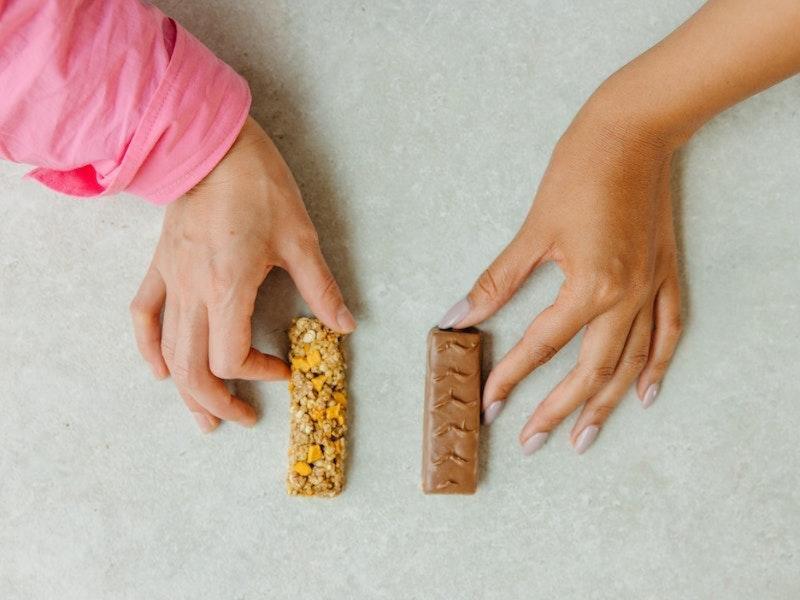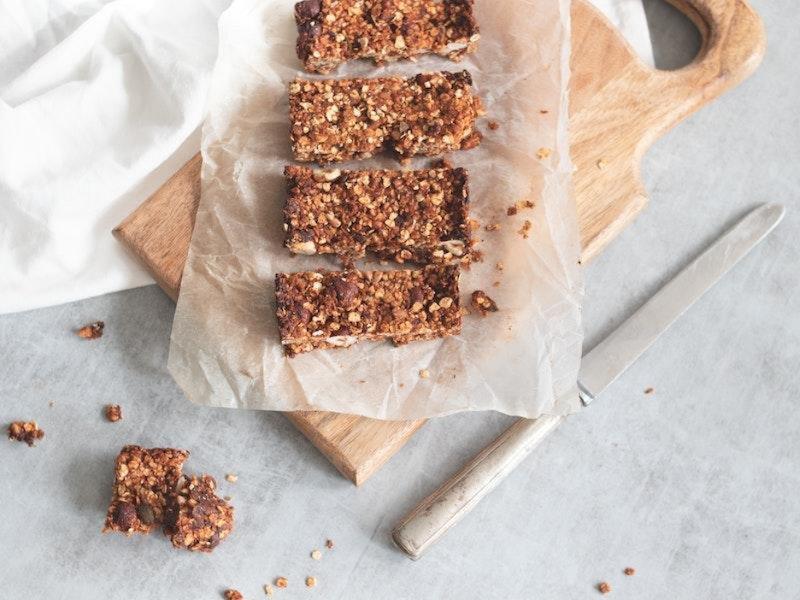We absolutely love protein bars: each one has something different to offer, and they make for a tasty and nutritious snack after hitting the gym.
Every protein bar is made differently. A lot of bars out there are labeled as “protein bars” but aren’t as healthy for you. While they may taste delicious, they’re not necessarily what you’re looking for after a long workout.
In this article, we’ll go through everything we know about protein bars from buying and trying them over the years, including ingredients to look for, ingredients to avoid, and tips to help you find your new favorites.
Why Should I Eat Protein Bars?
So why are protein bars great? They’re used for lots of different things, such as:
- A post-gym muscle-repairing snack
- A quick and easy breakfast
- An on-the-go snack for outdoor activities
- A pre-workout energy boost
- A diet-specific snack for losing or maintaining weight
Before you pick a protein bar, think about your reasons for eating them. The two most common are to meet fitness goals or to meet dietary needs.
Fitness Goals
As the name suggests, protein bars are high in protein, which helps repair your muscles after a workout. However, they’re also great for some pre-workout energy boost if you’re about to hit the gym.
If you plan to use your protein bars as pre-workout snacks, make sure you get some with higher carbohydrate content to give you that quick energy you’ll need.
For post-workout snacking, higher protein content bars are best to help your muscles heal.
Dietary Needs
Protein bars are sometimes used to help one lose, gain, or simply maintain their weight.
Bars with balanced macronutrients tend to work best as meal replacement bars, though those in higher protein also tend to keep you feeling fuller longer.
You should also keep the calorie count of your protein bar in mind. Higher calories may be beneficial if you’re trying to bulk up, but lower calories will help if you’re trying to shed some pounds.

What Should a Protein Bar Contain?
There can be lots of different ingredients in a protein bar, but the macronutrients remain the same. The main things to look at are protein, carbohydrates, and fats.
Protein
When it comes to protein bars, this is the star of the show and the way this product gets its name!
As I mentioned before, protein in an energy bar helps repair and grow your muscles and also helps to support your immune system. This is because proteins are made up of amino acids, which strengthen your immune cells like T cells and antibodies.
There are several places where the protein in your bar can come from. The most popular protein types include:
● Whey: comes from cow milk during the cheese-making process
● Casein: also comes from cow milk but digests more slowly than whey
● Soy: comes from soybeans and is fully plant-based
● Pea: comes from yellow split peas and is also fully plant-based
● Collagen: comes from animal tissue and has lots of amino acids
You’ll want to pick your protein type carefully. For example, if you’re vegan or vegetarian, opt for either soy or pea protein. Pea protein is also easily digestible for those with digestion issues.
However, whey protein and casein protein tend to be the most common, and is what many protein bars at the store will have in them.
For a bar to be considered a “source of protein,” it needs to be at least 12% protein. For high-protein bars, they need to be at least 20% protein.
In general, you can expect a protein bar to have anywhere between 10 and 30 grams of protein or more.
You should always look at the quality of the protein you choose. Make sure it has a complete amino acid profile, so you know you’re getting everything you need!
Carbohydrates
Though some dismiss carbs as unhealthy, we actually wouldn’t get very far without them. We still need some carbs to give us energy throughout the day.
Some protein bars have excessive amounts of carbohydrates due to their high sugar content. Many of these bars advertise extremely sweet flavors, which sound great until you read the label!
For some of you, high carbs are a good thing. For example, a high-carb protein bar is important if you’re an endurance athlete or are planning an intense workout.
An average bar can range anywhere between 10 and 30 grams of carbs or more per serving.
You should also consider any fiber (a type of carb) your protein bar contains, as this can greatly aid digestion and keep you fuller longer. Some examples of fiber ingredients you may see on protein bars include:
- Isomalto-oligosaccharides (IMOs)
- Inulin (Chicory root fiber)
- Soluble corn fiber
IMOs are the most common, but soluble corn fiber is becoming more popular because it is the easiest on your digestive system. Inulin is also pretty common, but can cause some GI distress if eaten in high quantities.
Fats
Though carbs normally steal the limelight when it comes to energy, fats actually provide you with a concentrated source of energy too.
However, it comes with a cost: the energy in fats is double the calories per gram than proteins and carbs.
This doesn’t mean fats are bad, though. In fact, fats are essential for absorbing nutrients, including fat-soluble vitamins like A, D, E, and K.
The three main types of fats you might see in your protein bars include:
● Saturated fats
● Unsaturated fats
● Trans fats
Saturated fats are any fats that are solid at room temperature, like butter and some coconut oils.
Unsaturated fats are generally considered healthier for you. For example, avocados are extremely high in unsaturated fats! These fats are important for brain function, heart health, and digestion.
Trans fats, on the other hand, are artificially created and are generally considered not good for you. They’re usually found in processed foods and have been linked before to increased risks of heart disease.
I recommend limiting the amount of trans fats you eat in your protein bars to stay as healthy as possible.
If you’re trying to lose weight, you’ll likely want to look for bars low in fat. If you’re looking to bulk up, high-fat protein bars can give you the quick calories you need throughout the day.

What Should I Avoid in Protein Bars?
Protein bars tend to have lots of yummy superfoods in them, such as whole grains, natural fats, and high-quality protein. Like any other product, they can, unfortunately, have bad ingredients too.
These bad ingredients are usually fillers and preservatives. Some foods have fillers to reduce production cost, while others have unhealthy preservatives to keep items shelf-stable longer. While this saves companies money, it isn’t necessarily healthy for you.
Here are some ingredients I recommend you look out for and avoid in protein bars.
Artificial Sweeteners
Artificial sweeteners are extremely common in weight loss foods, as they help sweeten your snack without increasing calories. However, some people have questioned the safety of artificial sweeteners, and others experience adverse reactions such as abdominal pain and diarrhea.
Ingredient names for artificial sweeteners may include:
- Acesulfame potassium (Ace-K)
- Aspartame
- Advantame
- Saccharin
- Sucralose
- Neotame
If you’re unsure about artificial sweeteners, it’s best to try to avoid them entirely.
High Fructose Corn Syrup
This sweetener is made from corn and is known to have negative health effects when eaten in high quantities, including weight gain and increased risk for heart disease.
Other names for high fructose corn syrup include:
- Glucose-fructose
- Isoclucose
- Maize syrup
- Glucose syrup
- Fruit fructose
- Crystalline fructose
Try to avoid protein bars with this ingredient.
Hydrogenated Oils
Hydrogenated oils tend to contain trans fats, which I mentioned above are not considered healthy. Your protein bars should ideally be made with healthy fats from nuts or seeds, for example.
Some different names for common hydrogenated oils include:
- Trans fats
- Trans fatty acids
- Partially hydrogenated:
- Cottonseed oil
- Palm oil
- Vegetable oil
- Soybean oil
- Canola oil
Artificial Flavors and Colors
Artificial flavors and colors have been controversial for a while, but they’re generally not considered healthy.
Some people have allergic or adverse reactions to artificial flavors and colors, so it’s not something you want to eat regularly.
Artificial flavors are usually described by type of flavor, but there are some specific artificial colors to look for:
- Blue no. 1
- Blue no. 2
- Red no. 3
- Red no. 40
- Yellow no. 5
- Yellow no. 6
- Green no. 3
Look for bars with natural flavors and colors instead.
Excessive Sugar
While high-carb protein bars may be good for some athletes, high sugar isn’t good for everyone. Snacks with lots of sugar can cause your blood sugar to spike up, which can cause an energy crash after a bit. It can also cause you to gain some weight over time if you eat it regularly.
Just because something doesn’t use the word “sugar” doesn’t mean it’s sugar-free, either. Some other names for sugar include:
- Fructose
- Galactose
- Glucose
- Lactose
- Dextrose
- Maltose
- Sucrose
If it ends in -ose, you should probably investigate further.
Instead, look for bars with low sugar or those sweetened with natural alternatives, like monk fruit.
Artificial Preservatives and Additives
We recommend avoiding any ingredient with the word “artificial” attached to it.
However, these preservatives and additives don’t always say they’re artificial. Other names include:
- Benzoate
- Propylene glycol
- Butylated hydroxyanisole (BHA)
- Nitrates
- Sulfites
- Carrageenan
- Propionate
Artificial preservatives and additives may help keep some products shelf-stable longer, but that doesn’t mean they’re good for you. Try to avoid any protein bars with unnecessary artificial thickeners or fillers.
Low-Quality Protein Sources
Low-quality protein isn’t going to do much for you. For example, collagen is a common source of protein, but it is actually missing some essential amino acids. That means if you go and eat a protein bar with this type in it, you won’t get all the nutrients you need.
Look instead for bars that contain high-quality, all-inclusive protein sources for the best nutrition possible.

How Do I Find the Ideal Protein Bar?
Here are some of my top recommendations for you the next time you go down the protein aisle.
Look at the Nutrition Label
The nutrition label tells you everything you need to know about a protein bar, including macronutrient content, ingredients, and calorie counts.
Reading this closely will help you figure out if the bar meets your requirements, whether you’re using it for dietary needs or to meet fitness goals.
It’ll also tell you any allergen information. So if you’re allergic to something like soy, you can avoid any protein bars using soy protein or other soy products.
Determine Macronutrient Ratios
As you’re looking at the nutrition label, consider the ratio of protein and carbs to fats.
Well-balanced bars are great for meal replacements, but bars higher in protein are better for post-workout snacking.
On the other hand, a ratio with higher carbs is better for a pre-workout energy boost.
For example, a bar with a 2:1 ratio of protein to carbs is good for fat loss, but a 1:2 ratio would be better for post-gym recovery.
This ratio can help you figure out what the bar is going to offer you, so be sure to try and find one that fits all of your needs.
Consider Taste and Texture
The ingredients of the protein bar don’t matter as much if you find it disgusting! We all have our own specific preferences when it comes to taste, so try to find some flavors that you really like.
If you’re new to protein bars, try to start with some more neutral flavors like vanilla and chocolate before diving into something extreme like “birthday cake.”
Texture matters too. If you want something with a crunch, for example, look for bars with nuts or seeds in them.
Look at Reviews
If you’re still not sure which protein bar to choose, try taking a look at some online reviews. Be sure to check out what the reviewer’s goals are, whether they’re trying to lose weight, work out more, or something else.
These reviews can also suggest which flavors tend to be better than others, so you’re more likely to find something delicious on the first try.
- Best Tasting Protein Bar
- Best Tasting Protein Bars
- Best Gluten Free Protein Bars
- Best Nut Free Protein Bars
- Best Protein Bars for Weight Gain
- Best Protein Bars for Runners
- Best Protein Bars for Diabetics
- Best Dairy Free Protein Bars
- Best Low Carb High Protein Bars
- Best Protein Bar Bodybuilding
- Best Protein Bars for Kids
- Best Protein Bar for Women
Other Useful Reading You Might Like
I’ve written other articles on protein bars and related recipes. Feel free to go and give them a read if you’re interested in incorporating more protein into your diet!
Protein Rich Recipes
- Raw chocolate protein bars
- High-protein oatmeal cookies
- Giant peanut butter protein cookies
- Oatmeal protein pancakes
- Healthy gluten free protein waffles
Final Thoughts
Protein bars are quick, nutritious, and can offer both your mind and body a lot in just a few small bites. Remember that the type of protein bar you get depends on your specific fitness needs or goals, as well as your preferences in terms of flavor, texture, and ingredients.
Whether you’re becoming a gym buff or simply want a simple breakfast you can eat in the car, there’s a protein bar out there for you.
